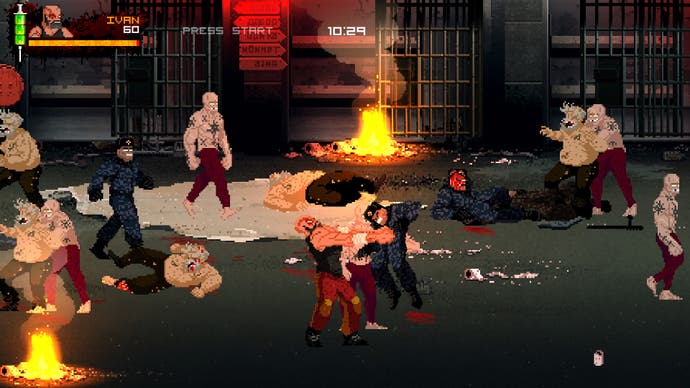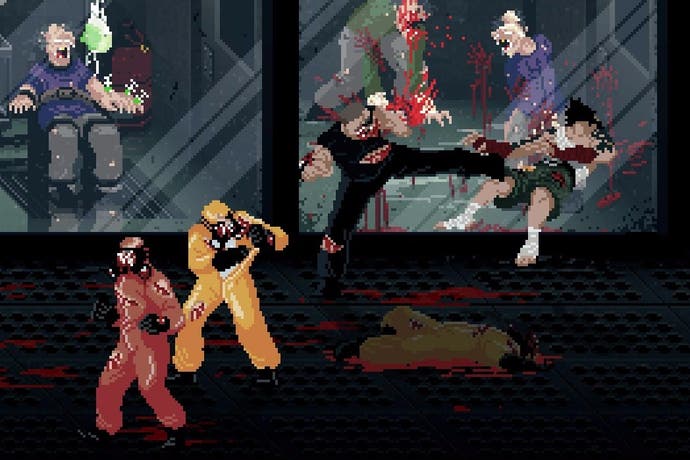Mother Russia Bleeds review
Soviet reunion.
In 1992's Streets of Rage 2 Eddie Hunter, better known to his friends as 'Skate', wore a yellow vest and red rollerblades. In a pinch he could roll into a tight little ball and, like a bowling ball striking a huddle of ninepins, send a crowd of bruisers wheeling through the air. Skate referred to his signature move as the 'Dynamite Headbutt.' Classic Skate.
In 2016's Mother Russia Bleeds, Boris wears a soiled bandage for a shirt and wanders shoeless. When he has withdrawal pangs, he is able to syringe chemicals from the convulsing bodies of the addicts that he's battered to the ground and inject the fluid into his neck. Boris refers to the drug, based on Krokodil, a real drug that, in the final stages of use, strips the skin from its user's flesh to expose the lurking bones, as Nekro. Classic Devolver Digital.
The publisher, in conjunction with French developer The Cartel is, in other words, banking on grimness and shock to bolster its bid to revive the long-departed scrolling beat 'em up. In contrast to Streets of Rage's Saturday morning TV take on street fighting, Mother Russia Bleeds' cast of characters are scab-pocked down-and-outers. The game's stages are lined with drug users, its streets run by small-time gangsters wearing tracksuits and gap-toothed grimaces. Your opponents don't disappear from the playfield when defeated. Instead, they shudder in a wet pool, perhaps while a passing pig sniffs at their crotch. Coupling a vintage video game aesthetic with the ultra-violence of films such as Nicolas Winding Refn's Pusher series to tempt modern audiences is a trick that worked for publisher Devolver Digital with Hotline Miami. Yet Mother Russia Bleeds unlocks whole new rooms of depravity. It is, after all, a game in which you can punch the head clean off a man's shoulders, and then use it as a weapon to strike another.

It's 1986 and communism isn't working for the USSR., where Mikhail, a simple-minded but affectionate pimp, organises bum-fights between his penniless fighters and strangers in the run-down streets. At the start of the game, your character, one of Mikhail's troupe, is kidnapped by a nefarious organisation (it's difficult to tell whether they work for the Mafia or the State) and thrown in a laboratory prison. You must escape and begin an inevitable tour of vengeance.
Mother Russia Bleeds is an orthodox scrolling beat 'em up. Four playable characters, positioned at different points along a spectrum between agility and power, come with a clutch of simple kicks, punches and slides, which can be strung together into combos. Unlike Street Fighter, this is not a game about manual dexterity so much as crowd-management: you trudge around the screen trying to ensure you're not beset by foes from two directions, firing off the odd flying kick to create space in which to move.
Each of the game's eight stages is laden with weapons - baseballs bats, chairs, wine bottles, discarded syringes, even the odd unmarked revolver - which can be wielded or thrown. Weapons add texture and interest to the limited suite of moves. It's possible to, for example, thwack a foe with a baseball bat against a wall and strike them again on the rebound, before the body hits the ground. Further interest is added in the form of Nekro, which must be drawn from the bodies of downed foes (they must be alive to do this, so there's an incentive to hold back from cracking skulls). Nekro can be either injected to replenish your character's health bar or, alternately, used to trigger a heightened battle state, when the environment blurs and your strength multiplies. In this berserker mode, you can punch enemies across the screen, or grab them to execute a gruesome one-hit fatality by, for example, breaking their back over your knee.
As in Konami's 1989 genre classic Teenage Mutant Ninja Turtles, up to four players can co-operate (single players can draft in a single AI-controlled comrade). This is a score attack game, which rewards varied combos, and is played against the clock. Unlockable syringes, which alter the effects of Nekro add further value, while the blocky pixel-art style is rich with interest and memorable detail, such as the sight of an opponent's tooth tinkling to the linoleum.

Yet even with its inventive boss battles (in one, you trade pistol shots with a thick-chested Soviet general, while a distant sniper lazily trails a red dot toward your chest, to keep you moving), Mother Russia Bleeds cannot quite dodge the historical problems of the genre, problems that were ultimately responsible for its demise. There's the regular difficulty of lining up your character with opponents on the Z-axis. There's the eventual monotony of the fighting. To slow players Le Cartelis heightens the game's difficulty (there's no way to adapt the challenge to your skill or store of patience), which further baits frustration and tedium. Then there's the relentless bloodletting, which slowly wearies the heart.
It may be churlish to criticise Mother Russia Bleeds for its crass depictions of violence when it dangles from a family tree of games that has always glorified violence. Skate, however, never laid into a drug-wrecked prostitute with a chair, after he started the fight by telling her that she "stinks of piss".
These are, as ever, pictures on a screen; nobody's getting hurt. But as you watch your bloodied character retching next to a pile of limp bodies in the aftershocks of a drug hallucination, the enduring feeling is one of exhaustion - of both interest and spirit. The ultra-violence is gratuitous and, damningly for a work clearly aiming to be transgressive, unsurprising.
In video games, an absence of violence is the only remaining way to shock an audience. Like a swastika scrawled onto a textbook, the familiarity and expectedness of pixel ultra-violence has been robbed of its ability to outrage. Beyond that, this is a game that has simply swapped one set of clichés - the US-centric mean streets of Final Fight and Streets of Rage - for another: Soviet brutality and poverty. There is undeniably sport to be had here, but no redemption, either for the characters, the players or the genre.










